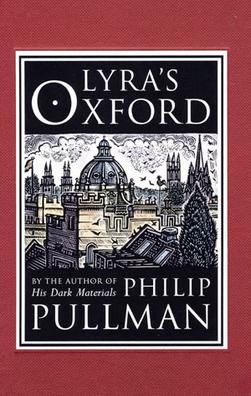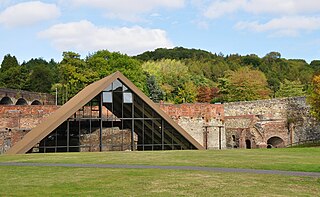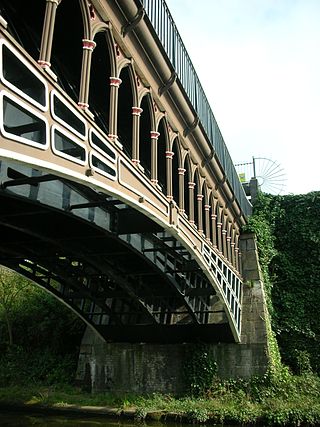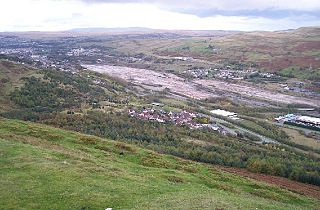
Braunston is a village and civil parish in the West Northamptonshire unitary authority area of Northamptonshire, England, next to the border with Warwickshire. At the 2011 Census, the parish had a population of 1,759. Braunston is situated just off the A45 main road and lies between the towns of Daventry and Rugby. Braunston is categorised by the Office for National Statistics as Suburbs and Small Towns: Suburbs There are 776 households in the village.

Lyra's Oxford is a 2003 novella by Philip Pullman depicting an episode involving the heroine of His Dark Materials, Pullman's best-selling trilogy. Lyra's Oxford is set when Lyra Belacqua is 15, two years after the end of the trilogy.

Elsecar is a village in the Metropolitan Borough of Barnsley in South Yorkshire, England. It is near to Jump and Wentworth, it is also 2 miles (3.2 km) south of Hoyland, 6 miles (9.7 km) south of Barnsley and 8 miles (13 km) north-east of Sheffield. Elsecar falls within the Barnsley Metropolitan Borough Ward of Hoyland Milton.

Coalbrookdale is a village in the Ironbridge Gorge and the Telford and Wrekin borough of Shropshire, England, containing a settlement of great significance in the history of iron ore smelting. It lies within the civil parish called the Gorge.

Jericho is an historic suburb of the English city of Oxford. It consists of the streets bounded by the Oxford Canal, Worcester College, Walton Street and Walton Well Road. Located outside the old city wall, it was originally a place for travellers to rest if they had reached the city after the gates had closed. The name Jericho may have been adopted to signify this 'remote place' outside the wall. As of February 2021, the population of Jericho and Osney wards was 6,995.

Westham was an unincorporated town in Henrico County, Virginia. It is located in the present day area of Tuckahoe, Virginia. Westham was built at a transportation point on the James River. The James River flows free for several hundred miles from the west and Westham is located at the point where the Fall Line rocks prevented further river passage. Richmond, Virginia was built on the other side of the fall line where the river is navigable to the ocean. This made Westham the first destination for iron used in Revolutionary War. In later years, Canals and then Rail transport connected Westham to Richmond along the James River trade route. Westham was eventually absorbed into Richmond.
Lucy Group Ltd, formerly W. Lucy & Co. Ltd, is a privately owned international group headquartered in Oxford, England. The company's origins date back more than 200 years when its principal business was manufacturing metal castings. Since then the business has evolved and steadily expanded into a group comprising four distinct business units. The group operates in 8 countries, from 16 locations, employing over 1,200 people.

The Horseley Ironworks was a major ironworks in the Tipton area in the county of Staffordshire, now the West Midlands, England.
The Oxford-Man Institute of Quantitative Finance is an interdisciplinary research institute of the University of Oxford, England. The institute was co-founded in June 2007 with Man Group plc. It brings together faculty, post-docs and students throughout the university interested in research into the quantitative finance applications of machine learning and data analytics.
William Hazledine was an English ironmaster. Establishing large foundries, he was a pioneer in casting structural ironwork, most notably for canal aqueducts and early suspension bridges. Many of these projects were collaborations with Thomas Telford, including the Pontcysyllte Aqueduct and the Menai Suspension Bridge.

Park End Street is a street in central Oxford, England, to the west of the centre of the city, close to the railway station at its western end.

Terence Lucy Greenidge was an English writer and actor. Greenidge was a friend of Evelyn Waugh, whom he met at Oxford, and collaborated with him in producing the Scarlet Woman: An Ecclesiastical Melodrama. Evelyn Waugh in Letters was published posthumously in 1994, which details many of Greenidge's recollections of Evelyn Waugh.

Blaenavon Ironworks is a former industrial site which is now a museum in Blaenavon, Wales. The ironworks was of crucial importance in the development of the ability to use cheap, low quality, high sulphur iron ores worldwide. It was the site of the experiments by Sidney Gilchrist Thomas and his cousin Percy Gilchrist that led to "the basic steel process" or "Gilchrist–Thomas process".
Daniel Harris was an English builder, prison governor, civil engineer, and architect prominent in Oxford.

Walton Well Road is a road, about 400 metres long, near the centre of Oxford, England. It provides a link from central Oxford to Port Meadow.

Ebbw Vale Steelworks was an integrated steel mill located in Ebbw Vale, South Wales. Developed from 1790, by the late 1930s it had become the largest steel mill in Europe. It was nationalised after World War II. As the steel industry changed to bulk handling, iron and steel making was ceased in the 1970s, and the site was redeveloped as a specialised tinplate works. It was closed by Corus in 2002, but is being redeveloped in a joint partnership between Blaenau Gwent Council and the Welsh Government.
Tredegar Iron and Coal Company was an important 19th century ironworks in Tredegar, Wales, which due to its need for coke became a major developer of coal mines and particularly the Sirhowy Valley of South Wales. It is most closely associated with the Industrial Revolution and coal mining in the South Wales Valleys.

Juxon Street is a street in the north of Jericho, an inner suburb of Oxford, England.

William Roberts and Company of Phoenix Foundry in Nelson, Lancashire, England, produced many of the steam engines that powered cotton weaving and spinning mills of Pendle and neighbouring districts. Industrial historian Mike Rothwell has called Phoenix foundry “Nelson’s most significant engineering site”.
Ketley Ironworks was an ironworks in Ketley, in Shropshire, England. Established in 1756, it was one of the largest ironworks in Britain during its ownership by William Reynolds and his brother Joseph.

















